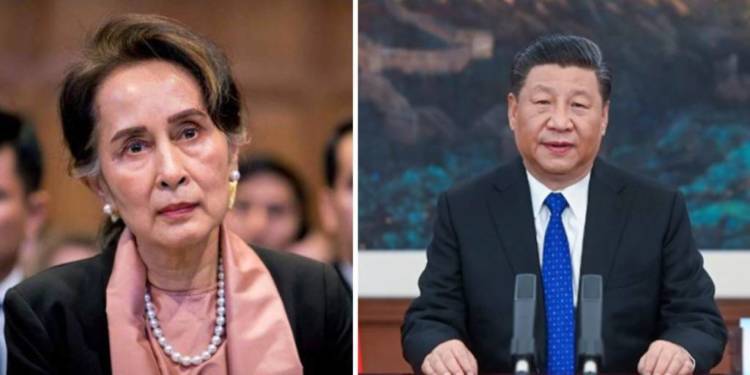Myanmar has been continuing on its path of pushing back against Chinese debt-trap game plans, and its latest move is bound to irk the Xi Jinping regime of China. Xi had visited Myanmar only in January this year, and had signed a series of agreements, which included the inking of a letter of intent on the development of Yangon City, including a new city project. The New Yangon City project is an element of the proposed China-Myanmar Economic Corridor (CMEC), which is part of the Belt and Road Initiative (BRI) – Xi Jinping’s flagship intercontinental infrastructure project.
According to Irrawaddy, however, in a snub to China, Myanmar has now opened up the Yangon city project for international firms as well, leading to compartmentalisation of the project. This comes as a huge pushback against China, and for the CCP, it is no less than a major setback. Earlier, China Communications Construction Company (CCCC) was all set to solely undertake the project in its entirety, which would help China seamlessly trap Myanmar under the burden of an extravagant debt, the geopolitical benefits of which it would reap over a prolonged period of time.
The said compartmentalisation of the project and involvement of foreign firms in it will go a long way in diluting China’s investment in Yangon city, which by the way, is connected to the Bay of Bengal by a river of the same nomenclature. As such, homogenous Chinese involvement in the mega-city project would give the paper dragon a clear entry into the Bay of Bengal by means of the CMEC, which too, has not kickstarted yet. However, such an eventuality has now been averted by Myanmar.
Myanmar is sufficiently wary of China’s enthusiasm for undertaking infrastructure projects in the country. While Pakistan and Nepal have succumbed to the debt-trap policy of China, Myanmar seems to have learnt its lessons from the mistakes of the two South Asian countries. As such, not only is the country pushing back against China by means of allowing international participation in New Yangon City project, but also by moving at a snail’s pace when it comes to other infrastructure projects which the Chinese were sure would help them gain geopolitical clout in the region.
Read: China has plans to turn Myanmar into another Pakistan, but people of Myanmar won’t let it happen
The China-Myanmar Economic Corridor, envisaged under the BRI much on the lines of the illegal CPEC, is yet to kickstart. There are three major Chinese projects in Myanmar- New Yangon City, the Kyaukphyu Deep-Sea Port and Industrial Zone, and the China-Myanmar Border Economic Cooperation Zones. Only recently, in the backdrop of the Coronavirus pandemic hitting Myanmar like all other countries of the world, the government had rolled out a seven-point economic relief plan. Under the said plan, it planned to work on implementing Labour-intensive Community Infrastructure projects. While many believed that this would end up speeding the pace of Chinese projects by cutting down on red-tapism, what happened, in reality, was quite the contrary. Burmese officials made it clear that no BRI projects would go through without sufficient scrutiny, pandemic or not.
On the other hand, India’s infrastructure push in Myanmar is meeting no such hurdles, and has the wholehearted support of all of Myanmar’s three important decision-making/influencing quarters, viz. the civilian government, the military leadership and the citizenry. As a matter of fact, the eastern neighbour is instead expediting Indian projects, even as China funds insurgents and armed militia of the country to destabilise not only Myanmar but also India.
China continues to actively collaborate with the Arakan Army of Myanmar, the terror group based out of the country’s Rakhine province. The CCP continues to supply arms and ammunition to the terror group, and that is concerning for India’s crucial $484 million Kaladan Multi-Modal transit project, which seeks to connect India’s North East to Myanmar’s Sittwe seaport. The project will enhance cross border trade between India and Myanmar and will also provide an alternate outlet to the landlocked Northeastern states, which are presently heavily dependent on the narrow ‘Chicken Neck’ at Siliguri.
China’s main interest in Myanmar is not the country itself, rather, the fact that it can serve as a gateway to China’s landlocked Yunnan province to be connected with the Bay of Bengal, and subsequently into what is considered India’s sphere of influence – the Indian Ocean. Entry into the Indian Ocean via Myanmar also helps China escape the horrors of its Navy being slaughtered in the Strait of Malacca by India and its allies. Too much is at stake for China when it comes to Myanmar. Myanmar, however, is leaving no opportunity to snub the paper dragon. With its latest move, the country has only reaffirmed the beliefs of many – that Myanmar is least interested in CMEC and BRI, and that it recognises both these grand projects as a rat-trap set by China.































